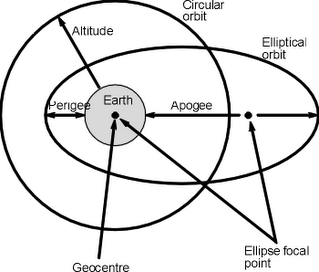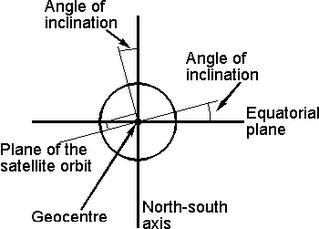GPS stands for Global Positioning System and it is a system that can provide a position at any point on the Earth's surface to a very high degree of accuracy. The Global Positioning System (GPS) uses 24 active Navstar satellites in orbit 11 000 miles above the surface of the Earth.
Using economic ground based receivers GPS is able to provide position information to within a number of metres. The economic costs have also meant that it is now fitted to many motor vehicles, while separate GPS receivers can be bought for a few hundred pounds or dollars. As a result it is widely used by private individuals, as well as many commercial and professional users. In fact the primary use for GPS is as a military navigation system. The fact that it is used so widely is a by product of its success.
Basic concept
GPS operates by being able to measure the distances from the satellites that are in orbit around the Earth. By knowing the distance from a number of satellites, it is possible to calculate the position on the Earth's surface and the height above it by a process of triangulation. This a great simplification, but this is essentially how it works.
The satellites all send timing information so the receiver knows when the message was sent. As radio signals travel at the speed of light they take a very short but finite time to travel the distance from the satellite to the receiver. The satellites also transmit information about their positions. In this way the receiver is able to calculate the distance from the satellite to the receiver. To obtain a full fix, four satellites are required, and when the receiver is in the clear, more than four satellites are in view all the time.
Satellites
The satellites are orbiting above the Earth. Their orbits are tightly controlled because errors in their orbit will translate to errors in the final positions. The time signals are also tightly controlled. The satellites contain an atomic clock so that the time signals they transmit are very accurate. Even so these clocks will drift slightly and to overcome this, signals from Earth stations are used to correct this.
The satellites themselves have a design life of ten years, but to ensure that there are no holes in service in the case of unexpected failures, spares are held in orbit and these can be brought into service at short notice.
The satellites are provide their own power through their solar panels. These extend to about 17 feet, and provide the 700 watts needed to power the satellite and its batteries when it is in sunlight. Naturally the satellite needs t remain operation when it is on the dark side of the Earth when the solar panels do not provide any power. This means that when in sunlight the solar panels need to provide additional power to charge batteries, beyond just powering the basic satellite circuitry.
Receivers
A large number of GPS receivers are available today. They make widespread use of digital signalling processing techniques. The transmissions from the satellites use spread spectrum technology, and the signal processors correlate the signals received to recover the data. As the signals are very weak it takes some time after the receiver is turned on to gain the first fix. This Time To First Fix (TTFF) may be as long as twelve minutes, although receivers that us a large number of correlators are able to shorten this.
When using a GPS receiver the receiver must be in the open. Buildings, or any structure will mask the signals and it may mean that few satellites can be seen. Thus the receivers will not operate inside buildings, and urban areas may often cause problems.
Applications
The primary use for GPS is as a military navigational aid. Run by the American Department of Defense its primary role is to provide American forces with an accurate means of navigation anywhere on the globe. However its use has been opened up so that commercial and private users have access to the signals and can use the system. Accordingly it is very widely used for many commercial applications from aircraft navigation, ship navigation to surveying, and anywhere where location information is required. For private users very cost effective receivers are available these days and may be used for applications including sailing. Even many motor vehicles have them fitted now to provide SatNav systems enabling them to navigate easily without the need for additional maps.
It can be said that GPS has revolutionised global navigation since it became available. Prior to this navigation systems were comparatively localised, and did not offer anything like the same degrees of accuracy, flexibility and coverage. Read more....!
Posted by Admin, Tuesday, January 16, 2007 12:12:00 PM
| 0 comments |
Using economic ground based receivers GPS is able to provide position information to within a number of metres. The economic costs have also meant that it is now fitted to many motor vehicles, while separate GPS receivers can be bought for a few hundred pounds or dollars. As a result it is widely used by private individuals, as well as many commercial and professional users. In fact the primary use for GPS is as a military navigation system. The fact that it is used so widely is a by product of its success.
Basic concept
GPS operates by being able to measure the distances from the satellites that are in orbit around the Earth. By knowing the distance from a number of satellites, it is possible to calculate the position on the Earth's surface and the height above it by a process of triangulation. This a great simplification, but this is essentially how it works.
The satellites all send timing information so the receiver knows when the message was sent. As radio signals travel at the speed of light they take a very short but finite time to travel the distance from the satellite to the receiver. The satellites also transmit information about their positions. In this way the receiver is able to calculate the distance from the satellite to the receiver. To obtain a full fix, four satellites are required, and when the receiver is in the clear, more than four satellites are in view all the time.
Satellites
The satellites are orbiting above the Earth. Their orbits are tightly controlled because errors in their orbit will translate to errors in the final positions. The time signals are also tightly controlled. The satellites contain an atomic clock so that the time signals they transmit are very accurate. Even so these clocks will drift slightly and to overcome this, signals from Earth stations are used to correct this.
The satellites themselves have a design life of ten years, but to ensure that there are no holes in service in the case of unexpected failures, spares are held in orbit and these can be brought into service at short notice.
The satellites are provide their own power through their solar panels. These extend to about 17 feet, and provide the 700 watts needed to power the satellite and its batteries when it is in sunlight. Naturally the satellite needs t remain operation when it is on the dark side of the Earth when the solar panels do not provide any power. This means that when in sunlight the solar panels need to provide additional power to charge batteries, beyond just powering the basic satellite circuitry.
Receivers
A large number of GPS receivers are available today. They make widespread use of digital signalling processing techniques. The transmissions from the satellites use spread spectrum technology, and the signal processors correlate the signals received to recover the data. As the signals are very weak it takes some time after the receiver is turned on to gain the first fix. This Time To First Fix (TTFF) may be as long as twelve minutes, although receivers that us a large number of correlators are able to shorten this.
When using a GPS receiver the receiver must be in the open. Buildings, or any structure will mask the signals and it may mean that few satellites can be seen. Thus the receivers will not operate inside buildings, and urban areas may often cause problems.
Applications
The primary use for GPS is as a military navigational aid. Run by the American Department of Defense its primary role is to provide American forces with an accurate means of navigation anywhere on the globe. However its use has been opened up so that commercial and private users have access to the signals and can use the system. Accordingly it is very widely used for many commercial applications from aircraft navigation, ship navigation to surveying, and anywhere where location information is required. For private users very cost effective receivers are available these days and may be used for applications including sailing. Even many motor vehicles have them fitted now to provide SatNav systems enabling them to navigate easily without the need for additional maps.
It can be said that GPS has revolutionised global navigation since it became available. Prior to this navigation systems were comparatively localised, and did not offer anything like the same degrees of accuracy, flexibility and coverage. Read more....!





